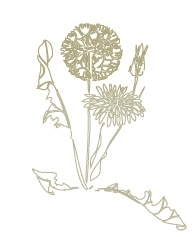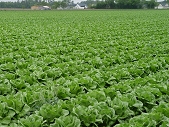Because lettuce is traditionally grown in a moisture- and fertility-rich environment, any weed that germinates has a favorable situation for competing. Controlling these weeds is critical for a productive lettuce crop.
Weed competition not only reduces lettuce yield, but reduces the quality of the head as well. Shrefler et al. (1996) showed that the weight of untrimmed lettuce heads was reduced 9 to 11 percent by a single spiny amaranth plant within 1.5 feet of a lettuce plant and that the weight and firmness of trimmed lettuce heads were reduced by 5 to 11 percent by a single plant within 3.5 feet of the lettuce. Data presented by Santos et al. (2004) showed that common lambsquarters interference in lettuce production for as little as 4.7 days can result in a yield loss greater than 10 percent.
Lettuce production in North Carolina is dictated by the temperature. Lettuce is adapted to cool growing conditions. It prefers temperatures of 60º to 65ºF. It will begin to flower if temperatures reach into the 70º to 80ºF range. To grow lettuce in the coastal plain and piedmont of the state, the crop must be grown in spring and fall. Lettuce may also be produced as a summer crop in the mountains at elevations above 3,000 feet (Sanders 2001). With its cooler climate requirement, lettuce faces competition from lingering winter annuals, such as wild mustard and shepherd’s purse, as well as early-season summer weeds, such as common lambsquarters. Common lambsquarters and pigweed species have been reported as major weeds in lettuce culture in the South. (Santos et al., 1998; Santos et al., 2004; Shrefler et al., 1994; Shrefler et al., 1996).
Several herbicide options are available for weed control in lettuce. No weed control program, however, should depend completely on herbicides. Cultivation can effectively control weeds, particularly early in the season when the cultivation can be achieved with little or no injury to the crop. More reliance on herbicides will be necessary in lettuce that is grown on plastic mulch.
Cultivation Options in Lettuce
Shallow cultivation can help to control weeds after they emerge between rows. Lettuce is shallow-rooted, and shallow cultivation (1.5 inches deep or less) is all that is necessary.
A grower’s ability to cultivate lettuce will depend on the type of lettuce grown and the chosen row spacing. Head lettuce is commonly grown in wide rows (30 to 42 inches apart) and lends itself to traditional cultivation activities. Configurations can vary with leaf lettuce. It can be grown in wide rows with two crop rows on a ridge or in a wide-bed (40- to 48-inch bed top) with three to four rows in narrow spacing. This narrow-row configuration is difficult to cultivate.
All efforts should be made to avoid tearing plastic mulch during a cultivation event, as this opening can give rise to further weed germination and interference.
Herbicide Options in Lettuce
Preplant and Preemergence
Glyphosate (Roundup and other trade names) may be applied prior to crop transplanting or emergence for control of emerged weeds. It will control susceptible weeds. Apply 0.5 to 1.5 pounds of active ingredient per acre. The rate of product per acre will change based on the particular formulation used. Perennial weeds may require higher rates of glyphosate. Be aware that some formulations of glyphosate have been manufactured with surfactants included and need no further adjuvants. If applying glyphosate prior to transplanting lettuce into plastic mulch, residues of glyphosate must be removed with ½-inch inch of rainfall or irrigation to prevent crop injury. See the product label for further details.
Paraquat (Gramoxone Inteon 2 SL, Gramoxone Max 3 SL, Firestorm 3 SL) may also be used to control emerged weeds prior to crop emergence. Paraquat will not translocate in plants as well as glyphosate. Apply it to small weeds. Pre-form beds several days before application to encourage maximum weed germination and emergence prior to treatment. Apply Gramoxone Inteon at 2.6 to 4 pints per acre and Gramoxone Max or Firestorm at 1.5 to 2.7 pints per acre (0.65 to 1 pound active ingredient per acre). These products may be applied with either a nonionic surfactant (16 to 32 ounces per 100 gallons of water) or a crop oil concentrate (1 gallon per 100 gallons of water). Paraquat used for preplant weed control over plastic mulch can injure transplanted crops that contact the plastic. Sufficient rainfall or irrigation is required to remove residual paraquat prior to transplanting. Because paraquat does not translocate within the plant, it has limited effectiveness on perennial weeds.
Benefin (Balan 60 WDG) applied at 2 to 2.5 pounds of product per acre prior to planting and incorporated into the soil will control annual grasses and small-seeded broadleaf weeds, including pigweed species. On coarse and medium soils (sand, loamy sand, sandy loam, loam, silt loam an silt), use the 2-pound-per-acre rate. On heavier soils, the higher rate may be necessary. See the label for specific instructions. Balan should be incorporated to a depth of 2 to 3 inches with a tandem disk or PTO-driven incorporating device. When applied and incorporated properly, Balan will control common lambsquarters and pigweed species.
Bensulide (Prefar 4 EC) is registered for use in lettuce only on mineral soils, preplant-incorporated or preemergence. The Prefar label claims control of only grass species when used in states other than Arizona, New Mexico, Texas, and California. The use rate is 5 to 6 quarts per acre, with a maximum of 6 quarts per acre per season. Incorporation to 1 inch is recommended if applying prior to planting. Research experience has shown that when using Prefar preemergence, irrigating immediately after application is required for best activity.
Pronamide (Kerb 50 WP) can be applied preplant or preemergence to lettuce at 2 to 4 pounds of product per acre. (It may also be applied postemergence to head lettuce as noted below). Kerb acts primarily through root absorption. Therefore, it will need to be moved into the root zone with mechanical incorporation or irrigation. The Kerb label claims control of several winter annual weeds as well as annual summer grass and broadleaf weeds, including common lambsquarters. Pigweed species are not listed as being controlled. This product may not be applied within 55 days of lettuce harvest and cannot be used on muck or peat soils as activity will be severely reduced. See the label for more specific instructions.
Postemergence
Carfentrazone (Aim 1.9 EW, 2.0 EC) may be applied to small, emerged weeds in lettuce as a hooded or shielded application to row middles between crop rows. Up to 2 ounces per acre may be applied at any one application, with a seasonal limit of 6.1 ounces per acre. Contact with lettuce during an application will result in crop injury.
Glyphosate (Roundup WeatherMax 5.5 L) may be applied as a hooded or shielded spray or wiper application to row middles between crop rows. Glyphosate must not contact the crop. Apply at 0.5 to 0.94 pounds of active ingredient per acre or 11 to 22 ounces of product per acre. Be aware that some formulations of glyphosate have been manufactured with surfactants included and need no further adjuvants. Glyphosate may not be applied within 14 days of harvest.
Pronamide (Kerb 50 WP) is labeled for use after head lettuce emerges for preemergence control of many grass and broadleaf weeds. Use rate is 2 to 4 pounds of product per acre. It is not recommended for use in muck soils. See the label for more specific instructions.
Sethoxydim (Poast 1.53 EC) and clethodim (Select 2 EC and other trade names, Select Max 1 EC) may be used postemergence in lettuce for control of emerged grass species. Clethodim may only be used in leaf lettuce. Neither of these products will have activity on broadleaf weeds or nutsedge species. Differences in grass control from the two products, applied at labeled rates, are small. Select is more efficacious on annual bluegrass, however, than Poast. Select is also considered slightly better at controlling perennial grasses, such as bermudagrass.
Poast can be applied at 1 pint to 1.5 pints per acre. It is recommended that you include a crop oil concentrate at 1 quart per acre with Poast. Rates of Select for lettuce range from 6 to 8 ounces per acre. Again a crop oil concentrate is recommended. When using Select, the crop oil concentrate should be added at a rate of 1 quart per 100 gallons of water. The addition of a crop oil concentrate to either of these products may increase the chances of crop injury. Applications of these products should be made on days that are not unusually hot or humid.
Select Max (1EC) may be applied at 9 to 16 ounces per acre for emerged grass control. The label for Select Max allows the use of nonionic surfactant at 2 pints per 100 gallons of water to reduce the risk of crop damage that may occur by using a crop oil concentrate.
Poast may not be applied within 30 days of harvest of head lettuce and 15 days of harvest of leaf lettuce. Select and Select Max may not be applied within 14 days of harvest.
Recommended Weed Management Programs
Preplant: Glyphosate or Paraquat
Preplant incorporated: Benefin or Pronamide
Preemergence: Pronamide
Postemergence: Cultivation or Glyphosate in row middles. Sethoxydim or Clethodim for emerged grasses. Pronamide (head lettuce only).
Resources
Sanders, D. C. 2001. Lettuce Production (HIL-11). N.C. Cooperative Extension Horticulture Information Leaflet. Raleigh: N.C. State University.
Santos, B. M., J. A. Dusky, W. M. Stall, D. G. Shilling, and T. A. Bewick. 1998. Phosphorus effects on competitive interactions of smooth pigweed (Amaranthus hybridus) and common purslane (Portulaca oleracea) with lettuce (Lactiva sativa). Weed Sci. 46:307-312.
Santos, B. M., J. A Dusky, W. M. Stall, and J. P. Gilreath. 2004. Effects of phosphorus fertilization on common lambsquarters (Chenopodium album) duration of interference in lettuce (Lactiva sativa). Weed Technol. 18:152-156.
Shrefler, J. W., J. A. Dusky, D. G. Shilling, B. J. Brecke, and C. A. Sanchez. 1994. Effects of phosphorus fertility on competition between lettuce (Lactiva sativa) and spiny amaranth (Amaranthus spinosus). Weed Sci. 42:556-560.
Shrefler, J. W., W. M. Stall, and J. A. Dusky. 1996. Spiny amaranth (Amaranthus spinosus L.), a serious competitor to crisphead lettuce (Lactiva sativa L.). Hort. Sci. 31:347-348.
Always read and understand the entire label prior to using any herbicide.
Prepared by
Roger B. Batts, David W. Monks, Wayne E. Mitchem, and Katie M. Jennings
Department of Horticultural Science
Publication date: Jan. 1, 2008
Reviewed/Revised: Jan. 30, 2024
AG-700-03
Recommendations for the use of agricultural chemicals are included in this publication as a convenience to the reader. The use of brand names and any mention or listing of commercial products or services in this publication does not imply endorsement by NC State University or N.C. A&T State University nor discrimination against similar products or services not mentioned. Individuals who use agricultural chemicals are responsible for ensuring that the intended use complies with current regulations and conforms to the product label. Be sure to obtain current information about usage regulations and examine a current product label before applying any chemical. For assistance, contact your local N.C. Cooperative Extension county center.
N.C. Cooperative Extension prohibits discrimination and harassment regardless of age, color, disability, family and marital status, gender identity, national origin, political beliefs, race, religion, sex (including pregnancy), sexual orientation and veteran status.


